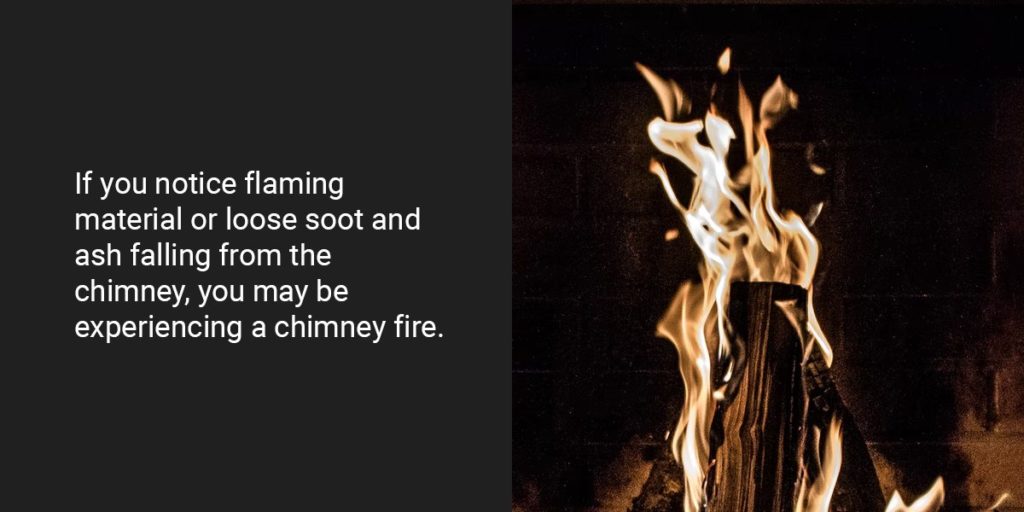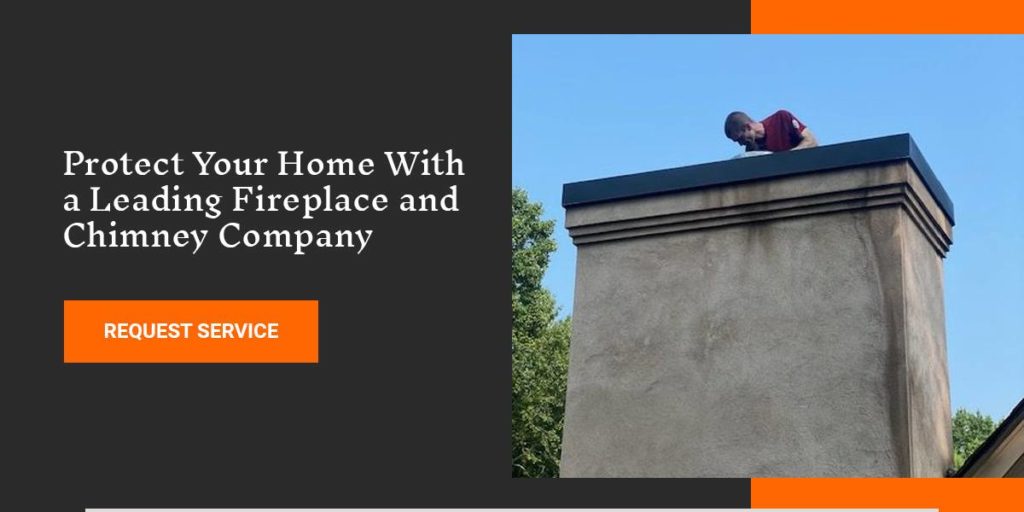
Your fireplace is designed to be a relaxing and warming aspect of your home, but improper maintenance could be dangerous and lead to a chimney fire. Routine chimney inspections and cleanings reduce this risk, and understanding why chimney fires start can help keep your family and home safe.
What Is a Chimney Fire?
Chimney fires happen when combustible material in your chimney catches fire. Flammable substances, including soot and creosote, may build up on the chimney flue as you burn wood. The sides of the chimney are significantly cooler than the fireplace, where combustible material is burnt. The material may start to cool as it rises, sticking to the flue’s sides.
These combustible materials are only partially burnt, meaning if they get hot enough, they can catch fire again. A chimney fire can severely damage the chimney flue, which is not designed to withstand the high temperatures of an open flame. In severe cases, chimney fire flames can spread to the roof or house itself, leaving behind costly repairs and creating an unsafe environment for your loved ones.
How to Recognize a Chimney Fire
There are two types of chimney fires — fast-burning and slow-burning. Both can be dangerous and cause severe damage. While fast-burning fires are often easy to notice, slow-burning fires can be just as destructive. One of the most hazardous aspects of a slow-burning fire is that it can go unnoticed, worsening and potentially spreading to other parts of the home. Understanding the basic signs of fast-burning and slow-burning fires can help keep you and your family safe.
While you may think a chimney fire is always easy to recognize, it largely depends on what type of fire you might be dealing with.
Fast-Burning Fire Signs

Fast-burning chimney fires occur rapidly and are, for the most part, extremely obvious as the fire consumes any combustible or flammable material present in the chimney flue. These fires are dangerous and spread quickly, making it incredibly important to call emergency services as soon as you suspect one to prevent further spread and property damage.
Some of the most common fast-burning fire signs include:
- Thick smoke: Chimney fires often cause dense, thick smoke to roll out the top of the chimney. In some cases, this thick smoke may even enter your home by traveling down the chimney flue and exiting through the fireplace. If you can’t see the smoke, you might be able to smell it or feel a burning in your sinuses. Smoke may also leave behind a soot-like residue on surfaces.
- Loud noises: Chimney flues may make noises during a chimney fire. You may hear a popping or crackling noise coming from inside, or even a loud roaring noise similar to a freight train.
- Flaming material from the chimney: In many cases, small pieces of debris — like a buildup of creosote or other flammable material — fall down the chimney as they burn. If you notice flaming material or loose soot and ash falling from the chimney, you may be experiencing a chimney fire.
- Strong odor: Another sign of a chimney fire is a strong order or intensely hot aroma entering your home. This smell is especially noticeable if you can still smell it after putting the fire out, indicating a fire continuing within the chimney.
Slow-Burning Fire Signs
A slow-burning chimney fire occurs when flammable or combustible material builds within the chimney flue. There, it can become hot enough to catch fire but lack enough oxygen or fuel to burn quickly. Slow-burning fires can be just as dangerous as fast-burning fires — possibly even more so, as they often go unnoticed until they’ve caused extensive damage.
Some of the most common signs of a slow-burning chimney fire include:
- Creosote flakes: If you notice flakes, shards or pieces of creosote on the ground, within the firebox or on the roof, this may be a sign of a slow-burning chimney fire. There may also be pieces of creosote that look like honeycomb or are fluffy.
- Damaged flue tiles: A chimney fire may also damage flue tiles, causing cracks or breakage. You may see a discolored or disfigured rain cap or chimney cap.
- Heat damage: Many property owners notice cracks in the masonry on the chimney’s exterior or the roof shingles and vents. Other signs of possible heat damage are melting or warping on the antenna or satellite dish near the chimney.
- Smoke escaping from chimney sides: Slow-burning fires may cause smoke to escape through the sides of the chimney, indicating damage or cracks inside the chimney flue that may have developed due to internal fire.
- Discolored components: You may notice warped or discolored metal components, indicating that they have been subjected to intense heat, typically from a chimney fire. Never touch a metal component if you suspect a fire.
How to Prevent Chimney Fires
Avoiding chimney fires in the first place is one of the most effective ways to stay safe and minimize the risk of damage. Routine fireplace and chimney inspection services can detect potential debris buildup that may result in a chimney fire. Professional chimney cleaning can also help break apart and remove creosote and soot buildup that leads to chimney fires.
If you have noticed signs of a potential chimney fire, dial 911 for emergency assistance. Following a chimney fire, you may require chimney lining repair or chimney cap services. A fireplace and chimney smoke inspection can determine if there is an issue within your chimney that may increase the risk of a chimney fire. Finally, masonry repair services can restore a fireplace and chimney after damage.
Protect Your Home With a Leading Fireplace and Chimney Company
At Atlanta Chimney Doctor, our certified chimney sweeps offer high-quality services to inspect, repair and protect your chimney and fireplace. Keeping your chimney clean and running properly is important and minimizes the risk of chimney fires. With every job, we provide the in-depth care and attention each person deserves. Our team of chimney cleaners is certified by the Chimney Safety Institute of America.
We take pride in our work and take every opportunity to go above and beyond your expectations. In addition to chimney maintenance and repairs, we provide you peace of mind knowing that your fireplace and chimney are clean and running safely. Our goal is to provide exceptional work at competitive rates and the highest level of customer satisfaction possible.
Request service online to get started with fireplace and chimney inspection and take your first steps toward a safer, more comfortable home.

